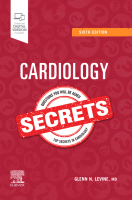Physical Address
304 North Cardinal St.
Dorchester Center, MA 02124

1 What are the contraindications for cardiac computed tomography? An inability to remain still, hold one’s breath, or follow instructions are relative contraindications to coronary computed tomography angiography (CTA). Anaphylactic reaction to intravenous iodinated contrast is considered an absolute contraindication,…

1 How does cardiac magnetic resonance imaging produce images? Cardiac magnetic resonance (CMR) uses a strong magnet 1.5 to 3.0 Tesla (equivalent to 30,000–60,000 times the strength of the earth’s magnetic field), radiofrequency pulses, and gradient magnetic fields to obtain…

1 What is positron emission tomography? A positron, as its name implies, is a positively charged particle that is ejected from the nucleus of an unstable atom. It is identical in mass to an electron. Strictly speaking it is “antimatter,”…

1 What is nuclear cardiology? Nuclear cardiology is a field of cardiology that uses radioisotopes to assess myocardial perfusion and myocardial function in different clinical settings, as well as radionuclide angiography and metabolic and receptor imaging. 2 What is myocardial…

1 How does echocardiography work? Echocardiography encompasses a group of applications using ultrasound to interrogate cardiac structures. Ultrasound technology utilizes acoustic (sound) waves, which are pulsatile pressure phenomena that travel through a transmission medium such as tissue. Like other waveforms,…

1 What are the major indications for ambulatory electrocardiography monitoring? Ambulatory electrocardiography (AECG) monitoring allows the noninvasive evaluation of a suspected arrhythmia during normal daily activities. It aids in the diagnosis, documentation of frequency, severity, length of episodes, and correlation…

1 What is the purpose of exercise stress testing, and how can a patient exercise during stress testing? Exercise stress testing (EST) using electrocardiography (ECG) is routinely performed to diagnose myocardial ischemia, estimate prognosis, evaluate the outcome of therapy, and…

1 Describe a systematic approach to interpreting a chest radiograph (chest x-ray). Common recommendations are to: 1. Begin with general characteristics such as the age, gender, size, and position of the patient. 2. Next examine the periphery of the film,…

1 What are the most commonly used voltage criteria to diagnose left ventricular hypertrophy? Numerous criteria have been established for the electrocardiographic (ECG) diagnosis of left ventricular hypertrophy (LVH). Below are the three that are used most frequently: R wave…

1 What are the auscultatory areas of murmurs? Auscultation typically starts in the aortic area, continuing in clockwise fashion: first over the pulmonic, then the mitral (or apical), and finally the tricuspid areas ( Fig. 2.1 ). Because murmurs may…